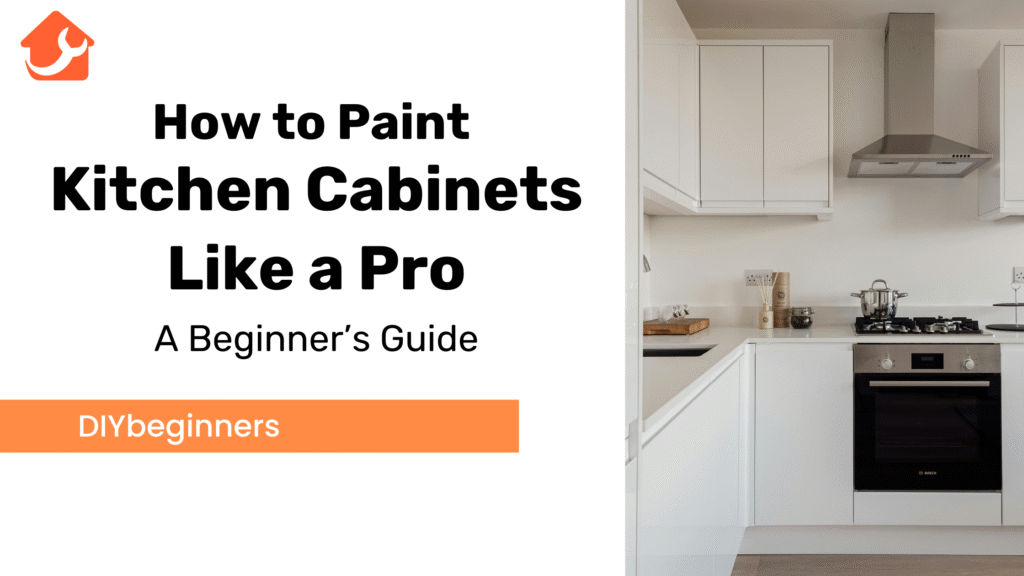
Do you want to modernise your kitchen with less expensive upheaval than a complete renovation? Mastering the process of painting kitchen cabinets will only take a few hours, but it may save you thousands of dollars in replacement costs. This handy document will lead you step by step through the entire process, giving the beginning photographer a chance to achieve professional results.
Why Paint Kitchen Cabinets Instead of Replacing Them?
By painting the kitchen cupboards, it becomes possible to make the cupboards look new despite the passage of some years. Among the benefits of this inexpensive alternative to replacement are the following:
- Cost savings of $5,000-$15,000 compared to new cabinets
- Ability to customize colors to match your style
- Opportunity to update your kitchen’s appearance without major construction
- An environmentally friendly option that reduces landfill waste
- Potential to increase your home’s value with an updated kitchen
Some of the initiatives involve the preparation methods and quality products that a person must learn to know how to paint kitchen cabinets. Respecting the process will also allow you to achieve such an excellent result with your DIY project.
Essential Tools and Materials to Paint Kitchen Cabinets
Before starting on your work on the project, you need to buy all the materials required. To achieve good results, it will make a great difference in the type of tools and materials you use.
Required Tools:
- Screwdriver or drill (to take off the hardware)
- Paintbrushes (angled brush measuring 2 inches for fine work)
- Foam rollers and frames (to ensure a smooth application)
- Putty knife (for filling in holes and flaws)
- Sandpaper with various grits (100-150 for initial sanding, 220-320 for sanding between coats)
- Tack cloth (to eliminate dust)
- Malerkrepp Abdeckfolie oder Plastikfolien
- Paint sprayer (not necessary, but results in the smoothest finish)
- Protective gear (dust mask, eye protection, gloves)
Required Materials:
- Degreaser or TSP cleaner
- Wood filler
- Premium bonding primer
- Paint specifically for cabinets (more on this below)
- Protective topcoat (optional, but advised)
Alkyd enamel is the recommended paint to use on kitchen cabinets by professional painters on the grounds of durability and a smooth finish. Nevertheless, the quality of acrylic enamel paints is much higher nowadays as they are easier to clean up.
Popular Paint Colors for Kitchen Cabinets in 2025
The latest colors in painting kitchen cabinets include soft white, blues, and greens, which give an elegant and timeless look. Common whites include the clean classic look of Benjamin Moore Simply White and Sherwin-Williams Alabaster, and blues vary in depth of richness with Benjamin Moore-Hale Navy to breezy softness with Sherwin-Williams Rainwashed. Greens also are in the know, and relaxing sage hues such as Benjamin Moore color named “October Mist” as well as the rich, gentle ultramarine called Sherwin-Williams color referred to as“Evergreen Fog.”
When it comes to a neutral but contemporary choice, warm gray colors like that of Benjamin Moore, which is called Revere Pewter, er or the cooler shade of Repose Gray by Sherwin-Williams, are supremely charming.
Another option that a great number of homeowners are welcoming is the dual tone effect, that is, combining the contrasting cabinet, upper and lower, white and deeper colored. Natural paint colors give a classic appeal, and more pronounced colors can give your cabinets a spectacular centerpiece in the kitchen.
How to Prep Kitchen Cabinets for Painting: Step-by-Step
It is essential to understand techniques of preparing kitchen cabinets with regard to painting to achieve adhesion and durability. As a matter of fact, professional painters tend to say that 80 percent of any good paint job is preparation.
1. Clear and Clean Your Kitchen
- Wipe off everything in the cabinets, countertops.
- Lay drop clothes on the countertops, appliances, and floors.
- Establish an assembly area of doors and drawers–in a garage, in a basement.
2. Remove Cabinet Doors, Drawers, and Hardware
- Make use of a screwdriver by taking off all the doors and drawers.
- Take out all the hardware; all hinges, handleand knobs.
- Painter’s tape can be used to label each part and the place of its positioning.
- Take a map or screenshots to remember the spot.
3. Clean Thoroughly
- How to prep kitchen cabinets for painting? The basic one is to get rid of everything, greasy and dirty.
- Wash walls and every surface using a degreaser or some TSP solution
- Inspect places close to the stove and handle them particularly well
- Rinse with water, clean, and let it air dry
4. Sand All Surfaces
- With the help of 120-150 sandpaper, sand all surfaces of the cabinets.
- grain of the wood along towards the side of the sand
- Pay attention to roughing the surface a bit to allow primer to bond to the surface, but do not remove the finish
- With the assistance of a tack cloth, the dust can be eliminated Sinus
5. Repair Damage
- Use wood filler and fabricate holes, scratches, or imperfections
- WashedryLotup Cogged
- Filling in the sand can be leveled out using fine-grit sandpaper
- Take the tape, tack cloth off of it
6. Final Cleaning
- Vacuum all the surfaces of dust
- Use a tack cloth to clean down, leaving no trace of dust behind
- Make sure that the surface is completely dry before moving leading to priming
Nothing is more important than preparation when you are learning how to prep kitchen cabinets to paint. Negligence of these steps is probably going to make the paint peel or chip prematurely.
Professional Techniques for Kitchen Cabinets Paint Application
Professional work is done by applying the kitchen cabinets paint in thin, even coats. The steps involved in the application include priming, painting, and finishing.
Priming Process
1. Apply Primer
- Apply an excellent bonding paint combined with primer such as KILZ 3 ® PREMIUM.
- A brush should be used in minute sections and on edges with a coating of primer..
- Flat areas ought to be rolled through a foam roller
- Work up bits and go wet edge
Let the primer dry(according to the instructions of the manufacturer)
2. Sand Primer
- With dry hands, lightly rub 220-grit sandpaper once dry
- Focus on surfacing, i. the production of a smooth surface
- Tack clothing wipes away the dust
Painting Process
Many homeowners wonder how to paint kitchen cabinets without leaving brush marks or streaks. These techniques will help:
1. First Coat Application
- Paints should be thoroughly stirred (cabinet paint should not be shaken)
- Cabinet frames/boxes in the kitchen would be a good place to start
- Use a high radiance and a soft, gentle brush.
- A level surface could provide the foam roller.
- Use thin coats, which are applied evenly (thick paint will drip and cannot cure well)
- The wood grain bears a stain tone of grain directionality
- Drying so well done (2448 hrs)
2. Between Coats
- Dry sand with 320-grit sandpaper so lightly
- Squeeze some dry brush tack cloth.
- At the scratchy or spill places, look..
3. Second Coat Application
- Coat again (by the same means), second time.
- Make it evenly distributed.. This point cannot be forgotten
- let it airdry ( 24-48 hours)
4. Cabinet Doors and Drawers
- Touch up the backs, dry up.. What do you say to it, shitless ones?
- t the front t, ts, then back paint theee
- CrCross-grainint
- On raised panel doors to be painted: inside panels first, then horizontal rails, then the vertical stiles.
Final Touches for a Professional Finish
Professional painters recommend these finishing steps for the best results:
1. Quality Inspection
- Look at cabinets under plenty of lights
- Seek areas of missed spots, drips and unevenness
- Requested touch up can be
2. Optional Topcoat
- Think about using of some extra layer of protection, or a topcoat to provide additional strength
- Water-based polyurethane is good on most cabinet paints
- During the same exercise use of application and paint came into the picture
3. Hardware Upgrade
- Look into new knobs, pulls or hinges
- This tiny little investment can also convert your cabinets
4. Reassembly
- Fit the doors and the drawers synchronously
- Any hinges that come out of line of sight should be rectified Correct
- To avoid brassing of doors use bumpers
Conclusion: Your Path to Professional-Looking Cabinets
By correctly painting kitchen cabinets as shown in this guide, one is able to get good results that are professional even at the beginning level of it. It is a time-consuming process that needs focus and detail orientation, but the transformation is worth it.
Remind that to succeed, one should have a good preparation, use quality materials and apply them carefully. Painted cabinets can last many years, without making familiar errors and adhering to the professional methods.
Depending on how much money you saved painting your cabinets instead of replacing them, you can even spare money to invest in other improvements to your kitchen with new counter tops or a new backsplash. These new additions will help people take advantage of the things you have done with your new paint work on the cabinets.
Are you ready to change your kitchen? Please your supplies, pencil in some time off (the better part of a weekend) and use this tutorial to do your kitchen cabinets like a pro. Your future wallet- and you- will be thankful.
